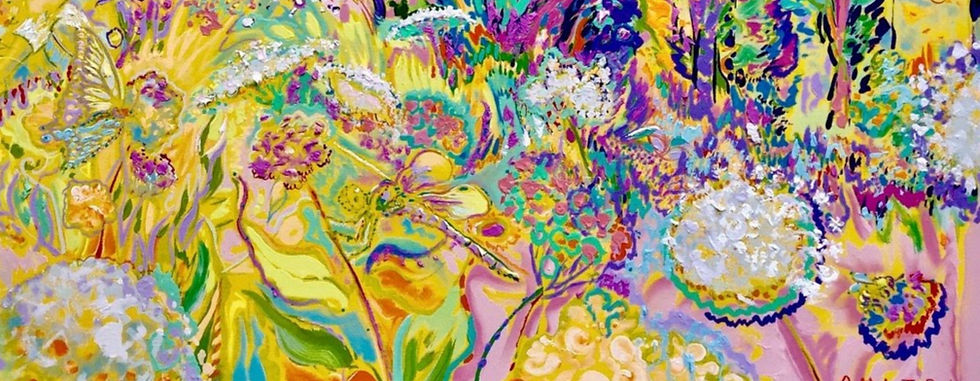Seven (7) Principles of The Intuitive Way
- Dmitri Wright
- Apr 30
- 4 min read
Updated: May 1

Impressionism has both a scientific and poetic approach. Most often, students are at a disadvantage as to how to proceed because their creative process is sidelined due to technical and procedural problems.
Even though the Impressionist masters rebelled against the Academy’s canon of historical symbolism, they still incorporated certain core principles into their techniques and methods. Beyond painting from one’s senses, there was sound reasoning behind their painting process. There are a set of universal principles that supported their intuitive way, which are still available for us today to use.
1. Imagine
2. Intention
3. Invention
4. Innovation
5. Improvisation
6. Integration
7. Illumination
Think of these seven principles as mental tools; keep them handy to help set the stage for working intuitively. These principles are there to keep you on track while developing your technical skills to allow your brush to dance. More ideas on these principles can be found in my “The Art of Creativity” Workbook.
1. Imagine - visualize in your moment
How to find yourself in the subject.
Begin by gazing. Reflect upon your first impression of your subject. Called the illuminated moment’. Begin by taking a mental picture of your scene, then integrate your thoughts and feelings as you move it toward an inspired whole idea. See in your mind’s eye what is meaningful and indispensable for you to reveal.
It is similar to a mindfulness exercise. Just listen to the still voice within and the prompting of your heart on what you should paint. Gazing is also what one does when working en plein air; it allows the landscape to speak to you on selecting a site to work from. It is the first step en plein air work before you begin to sketch.
Sketching is the way to lock in what matters most to you in your quest to be fully alive in the moment.
2. Intention - uphold your main idea
Overcoming chaos.
Establish your focal point and sort which objects are to be revealed. Trying to convey too many ideas defeats the canon of Impressionism. The goal is to share with your viewer your moment
Make several sketches to clarify your intention. It’s best to be of one mind and heart when asking the eye to grasp what is good, beautiful, and true.
3. Invention - design from your nature
Express your illuminated moment.
The illuminated moment is something that happens to you in which all that you have seen, heard, smelt, touched, and even tasted through your five sensations come together in one visual image of a moment in which you can visualize in your mind what is calling you to paint. It is when a picture is imprinted in your mind, one in which you can recall at any time as an ‘illuminated memory’. Creatives to be inventive to design from their own sensibilities.
4. Innovation – personalize your palette
An Impressionist painter owns the moment when they are in harmony with the palette. Most artists inherit their palette from their mentors or school of painting. However, mature painters develop their personalized palettes.
Select a color pigment that best communicates your personality—what I call finding your ‘Golden Color.’ Build a rainbow of pigments around that color that works well together. It is not unusual to have a different palette established for each subject (i.e., figure, portrait, landscape, or seasons.
5. Improvisation - Personalize your brushstrokes
Paint your own unique illustrative and expressive signature brushstrokes. Paint from your core values and let your personality show through. Impressionism is beloved because it’s a personalized view of the world.
Take time to practice and develop different kinds of brushstrokes, for instance, straight, curved, thin, thick, round, flat, puffy, wiggly, short, long, and so forth. Build an array that suits your temperament; let your rhythmic energy dictate the feel of your strokes.
6. Integration - gather your allies
The founders of Impressionism survived ridicule and scorn from those who controlled the art world and a public that was not accustomed to seeing anything other than what was approved by the art world leaders.
Because of their café culture, friendships, alliances, painting groups, dinner parties, and teamwork helped them grow and overcome that adversity. Gather in this moment of thoughts, images, insights, feelings, and images onto the canvas, and share it with your friends.
7. Illumination - reveal your own light and color
The Impressionists used the seven elements of light: highlight, direct light, shadow, reflected light cast shadow, transparent light, and translucent light. Paintings become luminous when quality and fresh pigments are used as pure as possible. The more paint is mixed with other colors, the more it dulls. Juxtapose your colors and use optical mixing with simultaneous contrast to engage the Impressionist’s illuminated effect.
The goal is to turn light into color, and color into matter in your unique way in your unique moment; then, you will be expressing what I call the eighth element of light—the transcendent light. This is when your brush dances a new impression. It is the mystery revealed through the work because it is your unique vision and technique that the spark in you begins to speak from the inside, your spirit, from Spirit.



Comments